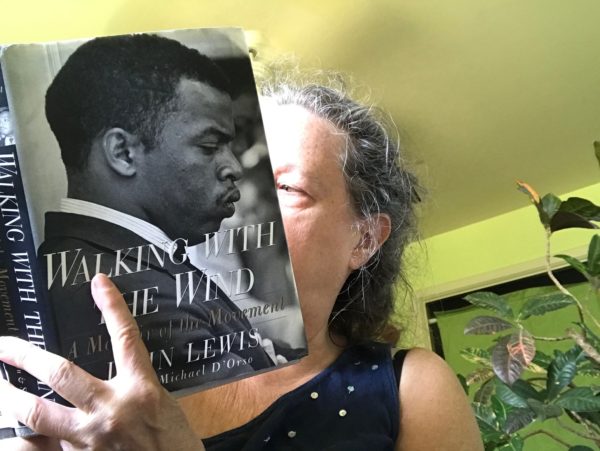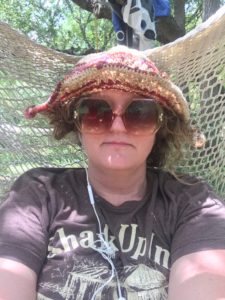Summer Reading List Art Spark Style
Summer speeds us toward a new normal. We hope it’s better than the normal that came before it. Reading is getting many of us through these days. Some Art Spark staff shared a little about what they are reading. Enjoy!
Walking With The Wind: A Memoir of the Movement: John Lewis with Michael D’Orso

“During this time of pandemic, one of the noticeable changes to my daily practice has been an inability to read. I can’t seem to focus on the page for longer than a few minutes, when I find myself putting the book down and wandering off to engage in some mindless task.
So, I have been pleased that my book, Walking With The Wind, A Memoir of the Movement: John Lewis with Michael D’Orso, has pulled me in to the life and times of this marvelous man, John Lewis. When I heard the story behind the title, I knew this was a book I had to read, and I have not been disappointed. The prose is engaging and has carried me away to the languid South, during the troubled days post slavery, when Black families worked the fields as sharecroppers, the lucky few working their own land.
When Robert, as his family called him, was a child of four years, he and around 14 of his siblings and cousins were playing in his aunt Seneva’s front yard, when a huge storm blew up out of nowhere. Seneva herded all the children inside where they huddled to wait out the storm. But the wind was determined to carry the house away; so all fifteen children, under the watchful eye of Seneva, held hands and walked to one corner of the house as it lifted off the foundation, and then across to another as it lifted. They walked this way throughout the course of the storm’s fury, and the house stood firm.
Although Lewis traveled far away from those early days, and often experienced violence against his body and his beliefs as he stood up to injustice, his roots always brought him home again.
As I read – because no, I have not finished the book yet – I value learning about a man whose heart and soul was dedicated to nonviolent protest. I hope that his example will live on in me, and the countless others who walk on his path, facing the wind and holding firm.” — Celia Hughes
How to Be an Antiracist by Ibram X. Kendi

“Reading for me the past few years has been through audio books. I usually read while I am relaxing in my hammock and I usually read fiction. Right now, I am reading Frankly in Love by David Yoon.
For this review, though, I wanted to discuss a non-fiction book that I read earlier this year. After the George Floyd tragedy, the Art Spark staff had a long talk in our staff meeting about what we could do as an organization to address the racial inequality in our society. We thought a good first step would be to do some reading, and someone suggested the book How to Be an Antiracist by Ibram X. Kendi.
What I really liked about this book was the way Kendi wrote and organized the chapters. He uses history, statistics, and memoir. He starts with an Introduction called My Racist Introduction. What a great equalizing start to the book! Starting with his own racism gives me, as a white woman, a chance to take a breath and feel like, okay, we are all learning together. No one segment of the population is being blamed here. It really made it easier to relax and open my mind to the subject matter.
Next, he moves on to a chapter called Definition. His definitions are simple and he continues to repeat them throughout the book. Simple, common sense reminders to cement the material.
The main takeaway I received from this book is that racism stems from racist policy making. If the policy, rule, or plan of action is designed with one race in mind, or based on a hierarchy of race, then everything that happens as an output of that policy is going to be racist.
So, what can I do to change this? I am not in charge of making policies. But then again, maybe I am. We can all start small. Each person can think of what policies they are in charge of in their life or their organization.
At Art Spark Texas, we follow an ethic of accommodation, meaning we look at everything we do from a lens of ensuring that each program is fully accessible for a variety of disabilities. This has become a commonplace practice for us. It shouldn’t be hard to shift our perspective to ensure that everything we do comes from a place of equality for all races as well.
I recommend this book, and look forward to other reading material suggestions anyone may have to further my knowledge on this subject matter.”– April Sullivan
Disability Visibility: First-Person Stories from the Twenty-First Century by Alice Wong

“This is a compelling anthology of personal essays around disability edited by San Francisco-based activist, writer, and podcaster Alice Wong. The collection came out in June of this year and paints a wide swath of disability-centered issues from a truly fantastic lineup of Deaf and Disabled contributors, as diverse as the topics they cover. But every piece shares a penchant for the power of stories to transform how we perceive ourselves and the world around us. These were not articles or chapters so much as feats of poignant and evocative storytelling–capable of yanking you out of your everyday life and thrusting you into the mind and heart of another.
As a cis, hetero, white guy, I valued the opportunity to hear the perspectives and experiences of the BIPOC, queer, trans, and gender nonconforming writers as well as those with disabilities unlike my own. These voices, largely underrepresented in mainstream media and disability narratives, fill the majority of the book. As a member of the disability community myself, I felt tremendous pride in the mind-boggling achievements of my sisters, brothers, and ancestors, and similarly inspired to press onward. There’s no shortage of heroes in this book!
My head spins at the impossible challenge of selecting just a few highlights to share. Every story possesses its own unique beauty and power, with surprises of discovery–affirming at times and shocking in others. I simply urge you to seek a copy when you can and chart your own path through the text.
Other things to keep in mind:
- Some essays are not for the faint of heart, but neither is disability–an experience that layers stigma and inaccessibility on already challenging limitations, especially for individuals who are multiply marginalized. Thankfully, the most triggering subject matter is indicated with content notes at the start of each story, allowing you to skip over or return when better prepared.
- The extensive Further Reading list at the back of the book is phenomenal! For those inclined to wade deeper into disability theory, culture, and/or literature, the reading list alone is worth the price of admission.
- An audiobook version is also available.”– Eric Clow
Most people had a summer reading list from school, and if they didn’t, their parents may have steered them towards some books to keep them occupied. Then there were those books that we found on our own and really enjoyed. Some of them may have even had a real and lasting effect. Or you simply enjoyed reading them purely for pleasure. We asked the Art Spark staff to name a few of those books from the recent or distant past.
- Dance, Dance, Dance by Haruki Murakami. “It is the first mystery novel that I was able to read without it being too scary. It wrapped me in the exciting and otherworldly story and made me fall in love with his books.” – Dance Director Silva Laukkanen
- The most enjoyable book I’ve read in the past few years is The Devil in the White City by Erik Larson – Mobile Art Director Theresa Zelazny
- The Magus by John Fowles This is a long one and it has everything—suspense, love, a ghost story, a puppet master pulling the strings, love, and ultimately, it’s a probe into moral consciousness. The story keeps you guessing throughout – What is real? What isn’t? And much of the book takes place on a beautiful Greek island. When I finished the book, I immediately read it again.—Outreach Director Susan Slattery
- Summer and Bird by local author Katherine Catmull. “A magical fantasy, coming of age book for girls. I couldn’t put it down as I followed the journey of two sisters as they search for their parents in the land called Down.”—Executive Director Celia Hughes
Psychology, Art, and Book Clubs – Gina P. Woodruff
- Abnormal Psychology and Principles of Social Psychology made up most of my summer reading for required classes. The Principles of Social Psychology class was a timely subject to delve into during the CoVID pandemic and black lives matter demonstrations. It explained the psychology behind why people act and respond the way that they do in group situations. We explored bias, prejudice, stereotyping, and the ways the groupthink mentality can easily influence individuals.
- As part of the Blanton docent/gallery teacher book club, I read Ninth Street Women, Lee Krasner, Elaine de Kooning, Grace Hartigan, Joan Mitchell, and Helen Frankenthaler: Five Painters and the Movement That Changed Modern Art by Mary Gabriel. This was a book is 944 pages long, and we had to break up the book into two sessions! It is a fantastic read if interested in learning how female artists changed modern art.
- A much shorter book (64 pages) the docent’s book club read—is a great stocking stuffer gift idea because it can fit in your pocket—This Is What I Know About Art by Kimberly Drew. “Kimberly Drew is a writer, curator, and activist. Drew received her B.A. from Smith College in Art History and African-American Studies. She first experienced the art world as an intern in the Director’s Office of The Studio Museum in Harlem. Her time there inspired her to start the Tumblr blog Black Contemporary Art, sparking her interest in social media. “
- For fun, my book club of almost 20 years read Beartown by Ferick Backman “Beartown explores the hopes that bring a small community together, the secrets that tear it apart, and the courage it takes for an individual to go against the grain.” and The Giver of Stars by JoJo Moyes. “The Giver of Stars is a lesson in valuing our connection with others, and finding love in the most unexpected of places. Based on the real-life stories of the WPA Packhorse Librarians, The Giver of Stars is a remarkable modern classic, Jojo Moyes at her most enthralling, romantic, and page-turning best.”
Read anything interesting this summer? Let us know in the comments or on social media.
